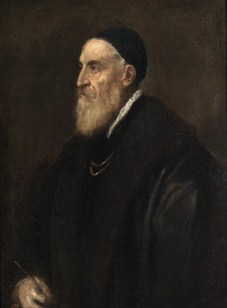Titian
 Titian (1480/90-1576) was born in Pieve di Cadore, in the Republic of Venice. A master of the use of color, he was at the head of a large workshop, which met with the patronage of kings and other powerful figures of the time. Jacopo Pesaro presentato a San Pietro da Alessandro VI (Jacopo Pesaro presented to Saint Peter by Pope Alexander VI) is the first known work of the artist, who as a child had moved to Venice with his brother Francesco to follow his artistic inclinations. There he met Giorgione, who had an undeniable influence on the young Titian, whose style can be seen in many of his early works. Titian’s early production begins in 1511 which clearly denoted his artistic autonomy, as evinced in three large frescoes for the main hall of the Scuola del Santo in Padua, where the painter had moved to escape the plague which was then raging in Venice. He returned to the city of the lagoon and became an accomplished artist, whose workshop received many commissions. Those years saw works such as the Nascita di Adone, (the birth of Adonis), the Noli me tangere, the Tre età dell’uomo (Three Ages of Man), Salomè con la testa del Battista (Salome with the Head of John the Baptist), Donna allo specchio (Woman at the mirror) and the famous Amor sacro e Amor profano (Sacred and profane Love). In 1513 he refused the invitation of Pope Leo X to move to Rome, and three years later became the official painter of the Venetian Republic. From that date Titian established himself as one of the richest and most famous artists in Europe. In addition to the large altarpieces and other famous Venetian works, he also worked for the Este of Ferrara, the Gonzaga of Mantua and the Della Rovere of Urbino. The help of his friend Pietro Aretino also allowed him to cross the boundaries of the Italian peninsula: his help was indeed crucial in order to allow Titian meet to Charles V in Bologna in 1530. The relationship between the artist and the emperor continued in subsequent years, which led to the execution of the great portraits of the king and his consort, especially the portrait of Carlo V a cavallo (Charles V on horseback), destined to become a model for all court portraitists of the following centuries.
Titian (1480/90-1576) was born in Pieve di Cadore, in the Republic of Venice. A master of the use of color, he was at the head of a large workshop, which met with the patronage of kings and other powerful figures of the time. Jacopo Pesaro presentato a San Pietro da Alessandro VI (Jacopo Pesaro presented to Saint Peter by Pope Alexander VI) is the first known work of the artist, who as a child had moved to Venice with his brother Francesco to follow his artistic inclinations. There he met Giorgione, who had an undeniable influence on the young Titian, whose style can be seen in many of his early works. Titian’s early production begins in 1511 which clearly denoted his artistic autonomy, as evinced in three large frescoes for the main hall of the Scuola del Santo in Padua, where the painter had moved to escape the plague which was then raging in Venice. He returned to the city of the lagoon and became an accomplished artist, whose workshop received many commissions. Those years saw works such as the Nascita di Adone, (the birth of Adonis), the Noli me tangere, the Tre età dell’uomo (Three Ages of Man), Salomè con la testa del Battista (Salome with the Head of John the Baptist), Donna allo specchio (Woman at the mirror) and the famous Amor sacro e Amor profano (Sacred and profane Love). In 1513 he refused the invitation of Pope Leo X to move to Rome, and three years later became the official painter of the Venetian Republic. From that date Titian established himself as one of the richest and most famous artists in Europe. In addition to the large altarpieces and other famous Venetian works, he also worked for the Este of Ferrara, the Gonzaga of Mantua and the Della Rovere of Urbino. The help of his friend Pietro Aretino also allowed him to cross the boundaries of the Italian peninsula: his help was indeed crucial in order to allow Titian meet to Charles V in Bologna in 1530. The relationship between the artist and the emperor continued in subsequent years, which led to the execution of the great portraits of the king and his consort, especially the portrait of Carlo V a cavallo (Charles V on horseback), destined to become a model for all court portraitists of the following centuries.
